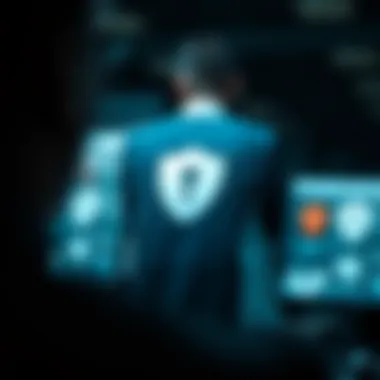ClevGuard Cracked: Legal, Security, and Ethical Insights


Intro
The conversation about software integrity often stirs the pot, particularly when it comes to mobile monitoring solutions like ClevGuard. While the idea of an all-seeing app sounds tempting, especially for tech enthusiasts, the approach of using cracked versions has its fair share of implications. Whether you're a developer testing capabilities or a parent trying to monitor your child's online activities, knowing the lay of the land regarding cracked applications is essential. It's not just some minor inconvenience; the stakes are high – legal hassle, security vulnerabilities, and ethical concerns could all come into play.
As we delve into the murky waters of cracked software, we’ll dissect the ramifications of using ClevGuard in an unauthorized manner. With an eye on both potential risks and the alternatives available, this article serves as a comprehensive guide to navigating these turbulent waters. Let’s get started.
Understanding ClevGuard and Its Applications
The discussion around ClevGuard and its functionalities is not merely a technical exploration; it serves as a vital framework for understanding modern software dynamics. ClevGuard, a versatile mobile monitoring solution, plays a critical role in various applications, especially as concerns about privacy and security continue to swell in today's digital world. This section elucidates why a comprehensive understanding of ClevGuard is imperative, particularly when muddy waters of cracked versions come into play.
Preface to ClevGuard
ClevGuard represents a unique move into personal monitoring software, catering to both individual users and families. Users rely on it for features like GPS tracking, app monitoring, and contact management, all designed to enhance safety and foster better communication lines, especially among children and teenagers. The software provides tools to oversee mobile device usage while respecting privacy, which is a balancing act that’s not always clear-cut. In an age where the lines between trust and oversight blur, ClevGuard aims to offer an answer to the pressing issue of digital trustworthiness.
As one navigates through the digital landscape, understanding how ClevGuard functions is essential. It's not merely an app; it's a pathway to ensuring that those who are important to a user are being monitored in a fair and responsible manner. Knowing lets potential users weigh their needs against the implications that ClevGuard's use brings.
Core Features of ClevGuard
ClevGuard isn’t just another app in a sea of similar offerings. It comes packed with a suite of features that often makes it the go-to choice for parents and employers looking to safeguard their loved ones or business investments. Here’s a closer look at some of the key functionalities:
- GPS Tracking: This feature allows users to pinpoint the exact location of a device in real-time, making it easier to connect or ensure safety in various settings.
- Call Monitoring: The ability to listen in on calls or view call logs provides insight into conversations taking place, though this can be a double-edged sword requiring careful ethical consideration.
- App Monitoring: ClevGuard enables monitoring of installed applications, allowing users to see which apps are getting the most attention and identify potential digital dangers.
- Web Filtering: Users can limit access to certain websites, thus providing a safeguard against unwanted content.
- Multilingual Support: ClevGuard’s accessibility in multiple languages broadens its appeal, drawing in users from diverse backgrounds.
While these features create a robust monitoring environment, they also draw attention to the complexities and responsibilities that come with such power. Choosing to use ClevGuard should involve a thorough consideration of both its impressive capabilities and the ethical responsibilities that accompany them. This is especially pertinent in the realm of privacy rights and informed consent. Knowing about the applications of ClevGuard builds an informed base for evaluating the further complications that arise when one encounters cracked versions of the software.
The Concept of Cracked Software
Understanding the concept of cracked software is essential for anyone navigating the current digital landscape. This phenomenon, while not new, has garnered various interpretations and implications—each carrying significant weight in discussions about software integrity and security. It stretches beyond mere technical aspects to engage with broader themes, such as legality, ethics, and user awareness. Understanding these nuances helps illuminate why the topic is important, especially in relation to applications like ClevGuard.
Definition of Cracked Software
Cracked software refers to applications that have been modified to remove restrictions placed by the original developers. This alteration often allows users to circumvent licensing agreements, which include periods of validity or fees associated with usage. Simply put, cracked software is akin to taking a shortcut—an appealing road for some and a risky journey for others. The act of cracking can involve breaking activations, altering protection mechanisms, or redistributing software illegally. The ramifications for users can stretch far and wide, impacting their systems, security, and even their legal standing.
For many tech enthusiasts, cracks are viewed with a mix of fascination and caution. While they open doors to potentially powerful tools without the typical financial burden, they also invite a host of concerns. Cracked versions often operate outside an ecosystem, one that typically includes user support, ongoing updates, and legal protections. These missing links drastically elevate the risk and pose significant questions:
- What happens if the cracked software contains malware or spyware?
- Will using such software result in legal consequences?
- Is the functionality of cracked software stable compared to legitimate versions?
Common Reasons for Cracking Software
The motivations behind cracking software are varied, but a few common threads weave through the fabric of this practice. Some of these include:
- Cost Savings: Many users, particularly students or small business owners, may find themselves in tight financial situations. The steep prices of software licenses can drive them toward cracked versions as a more appealing option, despite the risks associated with it.
- Access to Features: Users might desire advanced features locked behind paywalls. By cracking software, they can gain access without spending a dime. However, they often forfeit any form of technical support, updates, or, ultimately, the peace of mind that comes from using legitimate products.
- Experimentation and Learning: Some individuals, particularly developers, may crack software to understand its mechanics better. They use modified versions to play around with functionalities that interest them, gaining insight into programming and software operation. However, this approach poses ethical dilemmas, as the intention behind the action does not negate the act itself.
While users may have their reasons, they should tread carefully. The slippery slope of illegal software usage can lead to unintended consequences that weigh heavily on the user experience and integrity of their systems.


"Cracked software might seem like an easier route, but often ends up leading users down a path riddled with pitfalls."
In summary, understanding the concept of cracked software is not just an academic exercise. For tech enthusiasts, gamers, and developers, recognizing the implications surrounding illegal software practices is critical for making informed choices. It is vital to weigh the benefits against potential risks—meshing legality, security, and ethics into the digital discourse.
Potential Risks of Using Cracked ClevGuard
The discussion about cracked software often takes a backseat in the broader narrative of regulatory compliance and digital integrity. However, when it comes to ClevGuard, a mobile monitoring tool, understanding the potential risks associated with using its cracked version becomes not just important, but essential.
Using cracked ClevGuard opens the door to a plethora of issues that can wreak havoc on one’s devices and personal security. It's a bit like trying to parallel park a tank: it’s an attempt that can lead to disastrous results. When weighing the benefits of a cracked version against these significant risks, the scales tend to tip towards consequences that extend beyond mere inconvenience.
Legal Implications
Using cracked software can land users in deep legal waters, often without them realizing until it’s too late. Copyright laws are no joking matter. When someone uses a cracked version of ClevGuard, they are essentially bypassing licensing agreements. This not only violates the End User License Agreement (EULA) but can also lead to civil lawsuits from the software developers.
- Fines and Penalties: Individuals caught using cracked software may face financial consequences. Fines can range from a couple hundred to thousands of dollars, depending on jurisdiction.
- Prosecution: In severe cases, authorities might pursue criminal charges, leading to hefty penalties or, worst-case scenario, jail time.
The enforcement of digital copyright laws varies from country to country. However, the general consensus is that cracked software is illegal, and ignorance may not absolve one from liability. Users need to tread carefully and be aware of how easily they could find themselves on the wrong side of the law.
Security Vulnerabilities
The digital landscape can be a treacherous place, and using a cracked version of ClevGuard significantly increases exposure to numerous security threats. Cracked software often comes bundled with malware or viruses, which can compromise both user data and device integrity. The average person may not realize this until it’s too late, leading to irrevocable damage:
- Data Breaches: Cracked software is notorious for allowing hackers easy access to sensitive information stored on devices, including personal details or financial information.
- Device Vulnerability: The cracking process often strips away crucial security protocols, making devices susceptible to a myriad of cyber-attacks.
Ultimately, a cracked ClevGuard might be a double-edged sword—what seems like a short cut can lead straight to a digital disaster. In this age, where data theft is rampant, being careless about security can have lasting effects.
Ethical Considerations
The ethical debate surrounding cracked software is as murky as a swamp at midnight. On one hand, users might argue that they are simply trying out a product they can't afford; on the other, this stance fails to recognize the labor and resources put in by developers.
- Impact on Developers: Using cracked ClevGuard doesn't just cheat the system; it undermines the creators' ability to produce and update the software. If developers can’t profit from their hard work, innovation suffers.
- Stealing Trust: Engaging in piracy erodes the trust between consumers and developers. Ultimately, it can lead to fewer legitimate offerings in the market, harming users in the long run.
When it comes to software, it’s not merely about the gain users may receive. There is an ethical responsibility to consider why it might be more beneficial to support legitimate avenues rather than engaging in acts of digital theft that have far-reaching implications.
In essence, using cracked versions may offer a temporary solution, but the long-term consequences often leave users worse off.
Understanding these facets of potential risk can enlighten users, allowing them to make more informed decisions when navigating the complex world of software usage.
Technical Analysis of Cracked ClevGuard
The discourse surrounding cracked software, particularly in the context of ClevGuard, requires a close inspection of its technical aspects. This analysis not only showcases the functional disparities between legitimate and cracked versions but also highlights potential risks and performance issues. Understanding these technical nuances is vital for users who are weighing their options and considering the long-term implications of their software choices.
How Cracking Affects Performance
When you crack a piece of software like ClevGuard, you're essentially bypassing its built-in protective mechanisms. This action can have a range of effects on performance:
- Stability Issues: The modification of core files often leads to instability, making the software prone to crashes. Users may find that the application behaves erratically, hindering its reliability.
- Slower Execution: Cracked versions might not utilize components optimally. Patching a program can introduce redundancies or prevent it from functioning in alignment with its original coding, leading to sluggish performance.
- Feature Limitations: Cracking a program may result in the loss of features designed to promote user feedback or software updates. Users could miss out on critical functionalities certain functionalities, especially security updates that protect against vulnerabilities.


“The risk of performance issues is undeniable. A cracked version can feel like driving a sports car with the brakes cut.”
Understanding how such alterations affect performance is imperative. Users who rely on ClevGuard for critical monitoring tasks must consider whether the diminished performance compromises their objectives.
Comparison with Legitimate Versions
A thoughtful comparison between cracked ClevGuard and its legitimate counterpart underlines significant discrepancies:
- Security Protection: Legitimate versions benefit from ongoing support, including timely security patches. Cracked versions, however, often expose users to threats, opening the door for malware, spyware, or data breaches.
- User Experience: The user interface in the legitimate version is designed with user feedback in mind. Consequently, utilizing cracked software may present an unpolished or frustrating user interface that could jeopardize overall ease of use.
- Access to Support: Legitimate users can access customer service and technical support, which cracked software users cannot. In case of any issue, having a viable support network can be a game changer.
- Legal Concerns: Utilizing ClevGuard through illegal means can lead to legal ramifications. This is something that does not arise when engaging with authorized pathways and abiding by the terms of service.
User Experience and Support Issues
User experience and support issues are paramount when discussing software, especially in the context of cracked versions like ClevGuard. These factors are often overlooked by users drawn in by the allure of free access to features that are generally locked behind a paywall. However, the ramifications of a subpar user experience and lack of support can lead to significant headaches down the line.
Challenges in User Experience
Using a cracked version of ClevGuard may seem appealing, but it often leads to a frustrating user experience. Users may encounter numerous challenges such as:
- Instability and Bugs: Cracked software is usually more prone to crashing and performance issues. The lack of validation means that users might deal with unexpected glitches that can hinder their overall experience.
- Limited Functionality: Features that you might expect from the original software could be missing or not function as intended. For example, some tools for tracking or monitoring may not work properly, or worse, could execute incorrectly, leading to data loss.
- User Interface Confusion: Many cracked versions come with modified user interfaces that don’t provide a seamless flow, making it hard for users to navigate.
In a nutshell, a frustrating user experience can lead to users abandoning a tool altogether, rendering any potential savings moot.
Absence of Technical Support
Another major issue with cracked software like ClevGuard is the complete lack of technical support. When something goes awry, users find themselves in a predicament without options. Consider these challenges:
- No Official Assistance: With legitimate software, users usually have access to customer support through multiple channels. In the case of cracked software, there’s no one to turn to when problems arise. This can lead to increased frustration and lost time as users seek solutions independently.
- Risk of Malware and Security Threats: Often, cracked versions of software come bundled with malicious code, and without technical support, identifying such risks becomes a cumbersome process for users. This absence of help exacerbates security vulnerabilities that could have been remedied with proper guidance.
- Updates and Patches: Legitimate users benefit from continuous updates that improve functionality and security. Cracked software users miss out on these updates, leaving them vulnerable to newly discovered issues.
"In the digital age, sticking to what’s right isn’t just about legality; it’s about staying safe and ensuring a smooth user experience."
Further insights can be found through resources like Wikipedia and discussions on Reddit.
For those who still seek alternatives that maintain the core functionalities without risking their security, it’s recommended to explore credible sources.
Exploring Alternatives to Cracked ClevGuard
In today's digital age, where security and privacy are paramount, the topic of exploring alternatives to cracked ClevGuard holds significant weight. While some users might feel tempted to install cracked software due to cost or convenience, the ramifications can be dire. It’s crucial to understand that not only do cracked versions pose legal and security risks, but they also limit the user experience. By seeking legitimate applications, users can benefit from enhanced features, regular updates, and support from developers, all while steering clear of the moral quagmire of using unauthorized software.
Legitimate Apps Offering Similar Features
- mSpy: This trusty contender provides extensive monitoring capabilities, covering everything from location tracking to social media interactions. Users can rest easy knowing mSpy operates within legal bounds, ensuring peace of mind.
- FlexiSPY: Another worthy mention, FlexiSPY excels in offering a robust suite of monitoring features. From call interception to ambient listening, it delivers functionality that rivals ClevGuard.
- Spyic: Catering to both Android and iOS users, Spyic offers a user-friendly interface and powerful monitoring tools. Its seamless setup process makes it a go-to for users looking for straightforward solutions.
- KidsGuard Pro: Ideal for parental control, KidsGuard Pro emphasizes user safety and online behavior tracking, which is crucial for keeping younger users protected in today’s tech-heavy landscape.
By exploring these legitimate alternatives, users can find software that not only meets their monitoring needs but does so ethically and legally.


Pros and Cons of Alternative Applications
When weighing out options, there are always pros and cons to consider.
Pros
- Legal Assurance: One of the most reassuring aspects of authorized software is that you avoid legal troubles associated with cracked applications. Using legitimate software means you are not infringing on any copyrights.
- Update and Support: Users benefited from regular updates. This can include security patches and new features, ensuring the software remains effective and secure.
- Improved User Experience: Legitimate applications often come with well-designed interfaces and customer support, making them worth the investment.
Cons
- Cost Consideration: The obvious downside is that authorized applications typically come at a price that some users might see as exorbitant.
- Learning Curve: Switching to a new application, even if it is legitimate, may require some adjustment, particularly for users accustomed to cracked versions.
Closures and Recommendations
In this article, we've navigated the complex landscape surrounding ClevGuard, particularly focusing on the implications of using cracked versions. This topic is not only relevant but also critical for ensuring the safety and integrity of users’ digital lives. Understanding the potential pitfalls is paramount, especially as technology continues its relentless march forward, making security more crucial than ever.
Weighing Benefits Against Risks
When considering software like ClevGuard, weighing the benefits against the inherent risks can guide more informed decisions.
Benefits of Using Software Legally
- Full Functionality: Legitimate software often operates at its full capacity without imposing restrictions or limitations.
- Security Patches: Authorized versions receive consistent updates that fix vulnerabilities, keeping user data safe.
- Support Services: Users have direct access to customer support, ensuring timely help with any issues that may arise.
Risks of Using Cracked Software
- Legal Ramifications: Engaging with cracked software can land users in hot water, as it violates copyright laws.
- Financial Consequences: Beyond legal fees, compromised devices or stolen data could result in hefty financial loss.
- Unreliable Performance: Cracked versions might perform poorly, with bugs that hinder their functionality.
- Security Issues: Malware could easily accompany unauthorized downloads, jeopardizing personal information.
To round this out, it’s wise for users to constantly evaluate the trade-offs. Legal, uncracked software not only provides peace of mind but also supports the developers who invest time and resources into creating and maintaining the product. This supporting cycle fosters innovation, leading to more features and improvements, which benefits the user base at large.
As tech enthusiasts, gamers, and developers, making ethical software choices can lead to greater trust in the digital ecosystem. Always remember that in the end, safeguarding your data and supporting developers helps build a sustainable and secure future for everyone.
Final Thoughts on Software Integrity
In today’s rapidly evolving digital landscape, the concept of software integrity underscores the importance of using legitimate and secure applications. ClevGuard, like many software solutions, represents not just a tool for users but also a reflection of the principles of software development and user trust. The legitimacy of software affects not only the end users but also the broader ecosystem of developers and technology innovation.
The risks associated with using cracked versions of software extend beyond personal inconvenience. They echo through the integrity of the software industry itself. When users opt for unauthorized versions, they unintentionally contribute to a cycle that threatens the sustainability of the very tools they rely on. Supporting developers by purchasing legitimate software ensures they are compensated for their efforts, enabling ongoing innovation and improvement.
Importance of Supporting Developers
When individuals choose to support developers, they are fundamentally investing in the future of technology. The rationale behind this can be understood through several points:
- Sustained Innovation: Developers rely on revenue to fund research and development. Without enough financial support, many projects might stall, and new ideas might never see the light of day.
- Quality Assurance: Legitimate versions of software typically undergo rigorous testing. This translates into fewer bugs, improved performance, and more secure applications. Cracked versions, on the other hand, often come riddled with errors or security flaws that can jeopardize user data.
- Legal and Ethical Standards: Supporting developers adheres to the principles of intellectual property. By purchasing software, users respect the time and resources invested in creating those products, promoting ethical use within the tech community.
"Every time you click on that download link for cracked software, remember: somewhere, someone coded, designed, and poured their heart into that product. Your support makes a difference."
- User Support and Updates: Users of legitimate software often receive updates, security patches, and customer support. This added layer of assistance can be invaluable, especially when issues arise. Those using cracked versions must navigate the murky waters alone, often facing roadblocks that could otherwise be easily resolved.
To wrap it up, the journey toward maintaining software integrity hinges on user choices. The long-term implications of supporting legitimate products resonate not just with developers but also with the technology community as a whole. By fostering a culture that values authenticity and ethical use, users can help ensure a flourishing, sustainable digital environment. The choice to support proper channels plays a key role in enhancing overall digital safety.







